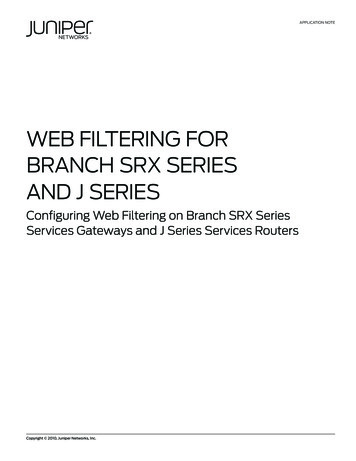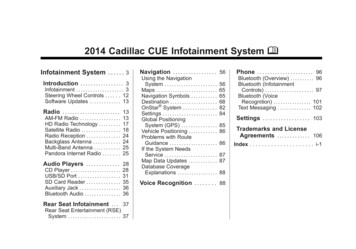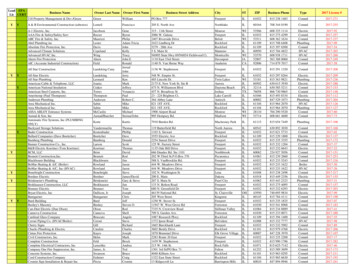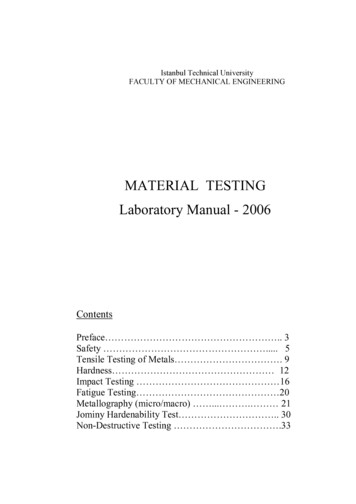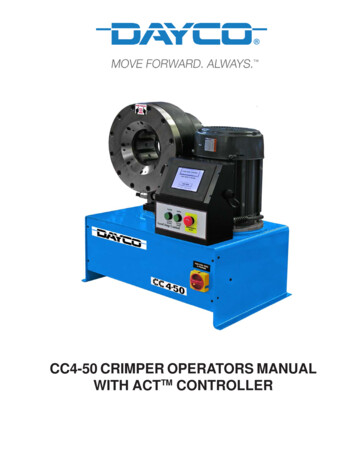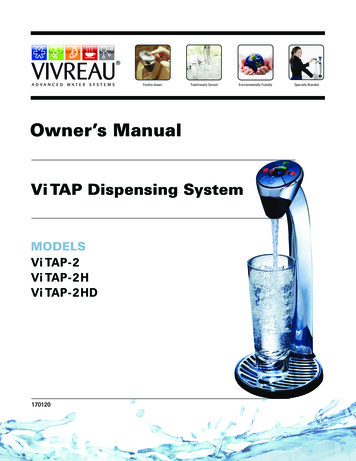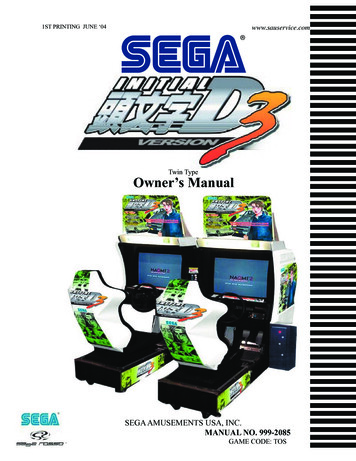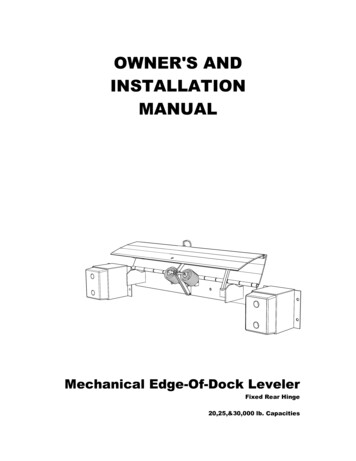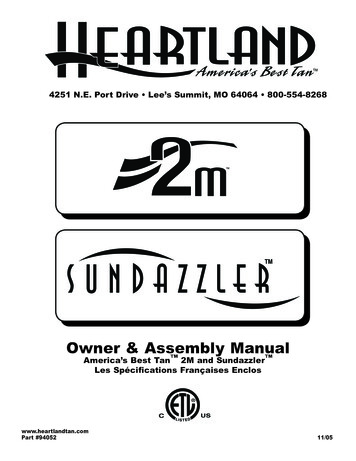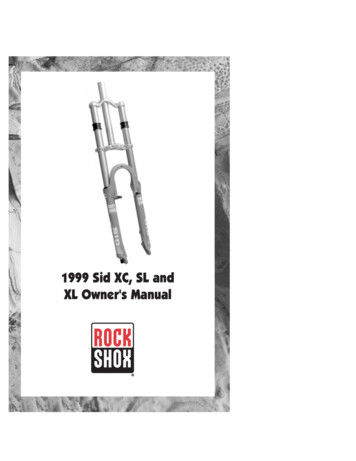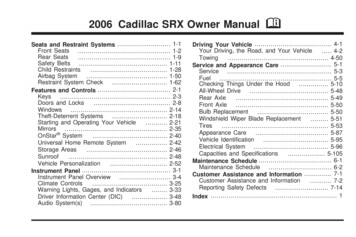
Transcription
2006 Cadillac SRX Owner ManualSeats and Restraint Systems . 1-1Front Seats . 1-2Rear Seats. 1-9Safety Belts . 1-11Child Restraints. 1-28Airbag System. 1-50Restraint System Check. 1-62Features and Controls . 2-1Keys. 2-3Doors and Locks. 2-8Windows . 2-14Theft-Deterrent Systems . 2-18Starting and Operating Your Vehicle. 2-21Mirrors . 2-35OnStar System. 2-40Universal Home Remote System. 2-42Storage Areas. 2-46Sunroof. 2-48Vehicle Personalization. 2-52Instrument Panel . 3-1Instrument Panel Overview . 3-4Climate Controls. 3-25Warning Lights, Gages, and Indicators. 3-33Driver Information Center (DIC). 3-48Audio System(s) . 3-80MDriving Your Vehicle . 4-1Your Driving, the Road, and Your Vehicle. 4-2Towing. 4-50Service and Appearance Care . 5-1Service . 5-3Fuel . 5-5Checking Things Under the Hood. 5-10All-Wheel Drive. 5-48Rear Axle. 5-49Front Axle. 5-50Bulb Replacement. 5-50Windshield Wiper Blade Replacement. 5-51Tires. 5-53Appearance Care. 5-87Vehicle Identification. 5-95Electrical System . 5-96Capacities and Specifications. 5-105Maintenance Schedule . 6-1Maintenance Schedule . 6-2Customer Assistance and Information . 7-1Customer Assistance and Information. 7-2Reporting Safety Defects . 7-14Index . 1
Canadian OwnersA French language copy of this manual can be obtainedfrom your dealer or from:GENERAL MOTORS, GM, the GM Emblem, CADILLAC,the CADILLAC Crest and Wreath, and the name SRX areregistered trademarks of General Motors Corporation.This manual includes the latest information at the time itwas printed. We reserve the right to make changes tothe product after that time without notice. For vehiclesfirst sold in Canada, substitute the name “GeneralMotors of Canada Limited” for Cadillac Motor CarDivision whenever it appears in this manual.Helm, IncorporatedP.O. Box 07130Detroit, MI 48207How to Use This ManualMany people read the owner manual from beginning toend when they first receive their new vehicle. If thisis done, it can help you learn about the featuresand controls for the vehicle. Pictures and words worktogether in the owner manual to explain things.Keep this manual in the vehicle, so it will be there ifit is needed while you are on the road. If the vehicle issold, leave this manual in the vehicle.Litho in U.S.A.Part No. 06SRX A First Printingii 2005 General Motors Corporation. All Rights Reserved.
IndexA good place to quickly locate information about thevehicle is the Index in the back of the manual. It isan alphabetical list of what is in the manual andthe page number where it can be found.Safety Warnings and SymbolsThere are a number of safety cautions in this book. Weuse a box and the word CAUTION to tell about thingsthat could hurt you if you were to ignore the warning.In the caution area, we tell you what the hazard is.Then we tell you what to do to help avoid or reducethe hazard. Please read these cautions. If you do not,you or others could be hurt.You will also find a circlewith a slash through it inthis book. This safetysymbol means “Do Not,”“Do Not do this” or“Do Not let this happen.”{CAUTION:These mean there is something that could hurtyou or other people.iii
Vehicle Damage WarningsVehicle SymbolsAlso, in this manual you will find these notices:The vehicle has components and labels that usesymbols instead of text. Symbols are shown alongwith the text describing the operation or informationrelating to a specific component, control, message,gage, or indicator.Notice: These mean there is something that coulddamage your vehicle.A notice tells about something that can damage thevehicle. Many times, this damage would not be coveredby your vehicle’s warranty, and it could be costly. Butthe notice will tell what to do to help avoid the damage.When you read other manuals, you might seeCAUTION and NOTICE warnings in different colorsor in different words.There are also warning labels on the vehicle.They use the same words, CAUTION or NOTICE.ivIf you need help figuring out a specific name of acomponent, gage, or indicator, reference thefollowing topics: Seats and Restraint Systems in Section 1Features and Controls in Section 2Instrument Panel Overview in Section 3Climate Controls in Section 3Warning Lights, Gages, and Indicators in Section 3Audio System(s) in Section 3Engine Compartment Overview in Section 5
These are some examples of symbols that may be found on the vehicle:v
NOTESvi
Section 1Seats and Restraint SystemsFront Seats .1-2Manual Passenger Seat .1-2Power Seats .1-2Power Lumbar .1-3Heated Seats .1-4Reclining Seatbacks .1-5Head Restraints .1-7Rear Seats .1-9Rear Seat Operation .1-9Stowable Seat .1-9Safety Belts .1-11Safety Belts: They Are for Everyone .1-11Questions and Answers About Safety Belts .1-15How to Wear Safety Belts Properly .1-16Driver Position .1-16Safety Belt Use During Pregnancy .1-22Right Front Passenger Position .1-23Rear Seat Passengers .1-23Rear Safety Belt Comfort Guides .1-26Safety Belt Pretensioners .1-28Safety Belt Extender .1-28Child Restraints .1-28Older Children .1-28Infants and Young Children .1-31Child Restraint Systems .1-35Where to Put the Restraint .1-38Lower Anchors and Tethers forChildren (LATCH) .1-39Securing a Child Restraint in aRear Seat Position .1-45Securing a Child Restraint in theRight Front Seat Position .1-48Airbag System .1-50Where Are the Airbags? .1-53When Should an Airbag Inflate? .1-57What Makes an Airbag Inflate? .1-58How Does an Airbag Restrain? .1-58What Will You See After an Airbag Inflates? .1-59Servicing Your Airbag-Equipped Vehicle .1-61Adding Equipment to Your Airbag-EquippedVehicle .1-61Restraint System Check .1-62Checking the Restraint Systems .1-62Replacing Restraint System PartsAfter a Crash .1-631-1
Front SeatsPower SeatsManual Passenger SeatIf your vehicle has power seats, the controls are locatedon the outboard side of the front seat cushions.Your vehicle may have a manual passenger seat.To adjust the seat, lift the bar under the front of the seatto unlock it. Slide the seat to where you want it andrelease the bar. Try to move the seat back and forth withyour body to be sure the seat is locked in place.1-2
Move the front of the horizontal control up or down toPower Lumbarraise or lower the front part of the cushion. Move the rear of the horizontal control up or down toraise or lower the rear part of the cushion. Lift up or push down on the center of the horizontalcontrol to move the seat cushion up or down. To move the seat forward or rearward, slide thehorizontal control forward or rearward.The vertical control is used for reclining your seatback.See Reclining Seatbacks on page 1-5 for moreinformation.Your vehicle may havethis feature. The driver’sand passenger’s seatbacklumbar support can beadjusted by movingthe control located onthe outboard side of theseat cushions.To increase or decrease support, hold the controlforward or rearward. Keep in mind that as your seatingposition changes, as it may during long trips, soshould the position of your lumbar support. Adjust theseat as needed.1-3
Heated SeatsIf your vehicle is equippedwith heated front seats, thebuttons are located onthe climate control panel.There is one button for the driver and one for the frontpassenger. Each button has three settings, LO, HIand off. The active setting appears on the climate controlpanel display. The LO setting warms the seatbackand cushion until the seat approximates normal bodytemperature. The HI setting has a slightly highertemperature.1-4To turn on the heated seats, press the button once.The seat will heat to the HI setting. Press the buttonagain to switch to the LO setting. Pressing the buttona third time turns the system off.The heated seats can only be used when the ignition isturned on. When the vehicle is turned off, the heatedseats automatically turn off. If you wish to have theheated seats on once the vehicle is restarted, pressthe button again.
Reclining Seatbacks{CAUTION:If the seatback is not locked, it could moveforward in a sudden stop or crash. That couldcause injury to the person sitting there. Alwayspress rearward on the seatback to be sure itis locked.To return the seatback to the upright position, pull up onthe lever without applying pressure to the seatback.Manual Recline LeverIf your front passenger’s seat has a manual recliningseatback, the lever is located on the outboard sideof the seat.Lift the lever to release the seatback, then move theseatback to where you want it. Release the lever tolock the seatback in place.1-5
Power ReclinerIf your vehicle has power reclining seatbacks, thecontrol is located on the outboard side of the front seats.Press the top of the vertical control forward or rearwardto adjust the seatback angle.1-6Do not have a seatback reclined if your vehicleis moving.
Head Restraints{CAUTION:Sitting in a reclined position when your vehicleis in motion can be dangerous. Even if youbuckle up, your safety belts cannot do theirjob when you are reclined like this.The shoulder belt cannot do its job. In a crash,you could go into it, receiving neck or otherinjuries.The lap belt cannot do its job either. In a crashthe belt could go up over your abdomen. Thebelt forces would be there, not at your pelvicbones. This could cause serious internalinjuries.For proper protection when the vehicle is inmotion, have the seatback upright. Then sitwell back in the seat and wear your safety beltproperly.The front seat head restraints can be adjusted up anddown. Pull up the head restraint to raise it. Pressthe button located at the base of the head restraint andpush down on the restraint to lower it. The front seathead restraints also tilt forward and rearward.1-7
If your vehicle has third row seats, the head rests areadjustable up and down and removable. Pull up on thehead rest to raise it. Press the button located at the baseof the head rest and push down on the rest to lower it.The head rests must be removed before the third rowseat can be folded. To remove the head rests, press thebutton located at the base of the head rest and pull thehead rest all the way out of the seat.Adjust your head restraint so that the top of the restraintis closest to the top of your head. This positionreduces the chance of a neck injury in a crash.The second row outboard head rests can be adjustedup and down. Pull up on the head rest to raise itand push down on the head rest to lower it. The secondrow head rests do not tilt. Your second row seat mayhave a head rest in the center position.1-8Store the head rests in the storage compartment behindthe third row. Open the cover and insert the head restposts through the slats in the storage area. The headrests must be stored with the front of the rest facing up.Position and snap the head rests in the providedstorage tray.
Rear Seats{CAUTION:Rear Seat OperationAdjusting the Second Row SeatThe second row seat can be adjusted forward orrearward. Pull up on the lever under the seat cushionand slide the seat with your body. Release the leverand try to move the seat forward and rearward tobe sure it is locked into place.If the seatback is not locked, it could moveforward in a sudden stop or crash. That couldcause injury to the person sitting there. Alwayspress rearward on the seatback to be sure itis locked.Entering or Exiting the Third Row SeatBe sure to return the seat to the original position whenfinished. Push and pull on the seat to make sure itis locked in place.The passenger’s side of the second row seat has aneasy entry feature. This makes it easy to get in and outof the third row seat, if your vehicle has one.Stowable SeatTo operate the seat, pull the release handle located onthe top of the seatback. Fold the seatback forward,then pull the release handle on the top of the seatbackto release the seat to tumble forward.If your vehicle has a third row seat, it is a powerfolding seat.The head rests need to be removed before folding thethird row seat. See Head Restraints on page 1-7 forinstructions for removing the third row seat head rests.The seatback will not fold all of the way down if thehead rests are not removed.1-9
Before folding or unfolding the third row seat, all of thefollowing conditions must be met: The liftgate or passenger’s side rear door mustbe open. The unlock button on either the remote keylessentry transmitter or the door must be pressedthree times to enable the rear seat for two minutes,or the ignition must be in ON or ACCESSORY. The vehicle must be in PARK (P). The vehicle cannot have a low battery.After the seat has folded, the panel on the seat must befolded forward to create the flat floor.Inside LiftgateThe buttons that are used to operate the power foldingthird row seat are located inside of the liftgate and behindthe second row seat on the passenger’s side of thevehicle.Two buttons are located inside the liftgate. One button isto tilt the seatback forward for added storage space orwhen storing a flat tire. The other button is the powerfolding seat button. The button behind the second rowseat is also a power folding seat button. Press and holdeither one of the two power folding seat buttons to foldthe seat.1-10If the seat’s path is blocked it will stop and back away.Press the button again to return the seat to itsprevious position.Before returning the third row seat to the passengerseating position, the panel must be folded backupon itself. Press and hold one of the power foldingseat buttons and the seat will unfold into the seatingposition. If the seat is not unfolded fully into the seatingposition, a chime will sound when the vehicle isshifted out of PARK (P). This indicates that the seat isnot ready for a passenger.Replace the head rests.
Safety Belts{CAUTION:Safety Belts: They Are for EveryoneThis part of the manual tells you how to use safetybelts properly. It also tells you some things you shouldnot do with safety belts.{CAUTION:Do not let anyone ride where he or she cannotwear a safety belt properly. If you are in acrash and you are not wearing a safety belt,your injuries can be much worse. You canhit things inside the vehicle or be ejectedfrom it. You can be seriously injured or killed.In the same crash, you might not be, if youare buckled up. Always fasten your safety belt,and check that your passengers’ belts arefastened properly too.It is extremely dangerous to ride in a cargoarea, inside or outside of a vehicle. In acollision, people riding in these areas aremore likely to be seriously injured or killed.Do not allow people to ride in any area of yourvehicle that is not equipped with seats andsafety belts. Be sure everyone in your vehicleis in a seat and using a safety belt properly.Your vehicle has a lightthat comes on as areminder to buckle up.See Safety Belt ReminderLight on page 3-36.In most states and in all Canadian provinces, the lawsays to wear safety belts. Here is why: They work.1-11
You never know if you will be in a crash. If you do havea crash, you do not know if it will be a bad one.A few crashes are mild, and some crashes can beso serious that even buckled up, a person would notsurvive. But most crashes are in between. In manyof them, people who buckle up can survive andsometimes walk away. Without belts they could havebeen badly hurt or killed.Why Safety Belts WorkWhen you ride in or on anything, you go as fast asit goes.After more than 30 years of safety belts in vehicles,the facts are clear. In most crashes buckling updoes matter.a lot!Take the simplest vehicle. Suppose it is just a seaton wheels.1-12
Put someone on it.Get it up to speed. Then stop the vehicle.The rider does not stop.1-13
The person keeps going until stopped by something.In a real vehicle, it could be the windshield.1-14or the instrument panel.
Questions and Answers AboutSafety BeltsQ: Will I be trapped in the vehicle after an accidentif I am wearing a safety belt?A: You could be — whether you are wearing a safetybelt or not. But you can unbuckle a safety belt,even if you are upside down. And your chance ofbeing conscious during and after an accident,so you can unbuckle and get out, is much greaterif you are belted.Q: If my vehicle has airbags, why should I have towear safety belts?or the safety belts!With safety belts, you slow down as the vehicle does.You get more time to stop. You stop over more distance,and your strongest bones take the forces. That is whysafety belts make such good sense.A: Airbags are in many vehicles today and willbe in most of them in the future. But they aresupplemental systems only; so they work withsafety belts — not instead of them. Every airbagsystem ever offered for sale has required the use ofsafety belts. Even if you are in a vehicle that hasairbags, you still have to buckle up to get the mostprotection. That is true not only in frontal collisions,but especially in side and other collisions.1-15
Q: If I am a good driver, and I never drive far fromDriver Positionhome, why should I wear safety belts?A: You may be an excellent driver, but if you
Vehicle Damage Warnings Also, in this manual you will find these notices: Notice: These mean there is something that could damage your vehicle. A notice tells about something that can damage the vehicle. Many times, this damage would not be covered by your vehicle
